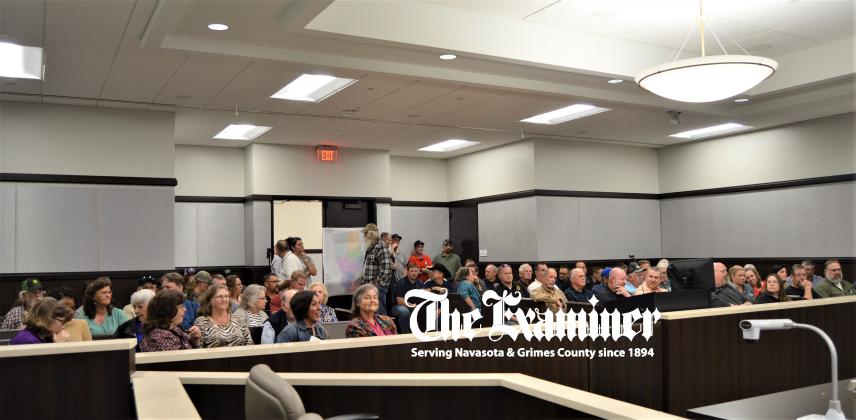Citizens respond to proposed ESD
Grimes County commissioners held a Public Hearing, Wednesday, Jan. 18, to receive comments about the creation of Grimes County ESD No. 2. The petition for the countywide ESD was initiated by Richards residents Michelle and Rick Gremillion and Terry Lowrey and presented to Commissioners Court Nov. 2, 2022.
Texas Health & Safety Code (THSC) 775.017 states that after a public hearing, if commissioners find that creation of the district is “feasible and will promote the public safety, welfare, health, and convenience of persons residing in the proposed district,” the commissioners court shall grant the petition, fix the district's boundaries, and impose any conditions negotiated under THSC 775.014.
While scheduled for the Feb. 1 commissioners court meeting, commissioners have until Feb. 17 to decide. If the petition is approved, the fate of Grimes County ESD No. 2 will be determined by voters in the May 6 General Election for Cities and Schools.
Opening comments
First to speak was Safe-D Interim Executive Director Clay Avery representing the petitioners. For volunteer fire departments (VFD) faced with poor equipment, lack of volunteers, increasing growth, Avery said ESDs can provide them more resources.
Speaking against a countywide ESD, Anderson resident Simmie DeVille posed a number of unanswered questions about the establishment of boundaries, anticipated tax base and revenue, income and expenditures, board selection, VFD representation, division of revenue, purchase and location of new ambulances and the future of current county funding.
Referring to generous local support, DeVille said, “People are always going to give a lot more money, in my experience, when they’re asked to give money rather than when they’re told to give money.”
Not the right time
Several VFD members with ESD ‘history’ said they were neither for nor against ESDs but think now is not the right time for Grimes County.
Whitehall resident Freeman Vickers called ESDs “a layer of state government, not county, not city, not township, but state government. Once created by referendum, local government has minimal control…and 10 times more difficult to remove, if at all.”
Bedias VFD’s Ozelle Covington recalled his experience in East Houston where an ESD board replaced the VFDs with paid firefighters.
Shiro residents Dan Sharron called the proposal “an open-ended contract…with no language about what the agreement will be with the VFDs,” Judith Bennett opposed additional taxation and a board unaccountable to the voters and Annabeth Neeson called the proposed ESD tax “a burden on people.”
Anderson residents Joseph Reznicek called for a feasibility study, saying an EDS is “not a quick fix, not a quick solution,” and Marc Benton stated the estimated $125 tax on a $125,000 home “means a lot to a lot of people in Grimes County.”
Don Brame of Richards pointed out the $30,000 price tag of an election.
Bob Leeper, treasurer of ESD No. 1 in Iola, attributed that ESD’s success to its residents’ desire to support a local ESD and called creating a countywide ESD “opening a can of worms.”
Todd Mission City Manager Neal Wendele and Anderson Fire Chief Michael Kimich rebutted claims that ESDs would lower ISO ratings and insurance premiums in rural areas citing lack of fire hydrants and the need for better roads, communication and water supply.
Lack of information about ESDs was another repeated concern.
Petitioners’ turn
Michelle Gremillion called the County’s low tax rate a roadblock to improving county services, with needs outpacing revenue capability. The ESD would allow Grimes County to serve all fire departments “with a broad distribution of funds.”
She continued, “There are a variety of ways to budget according to tax revenue within each fire district and still provide for countywide needs”
Terry Lowrey said that while not in favor of more taxes, he places a high priority on the safety and security of his family, friends and property.
Referring to the Bedias City Council’s Resolution to allow its citizens to vote on an item it doesn’t support, Rick Gremillion reminded the court that it’s not in the purview of those commenting or the court to decide if the district exists.
He said, “Texas law has put the decision on this matter in the hands of the voters of Grimes County. We would be wrong to usurp from those voters that very democratic process to vote for or against the district.”
During the near 90-minute hearing, 22 comments were received with 17 opposed.
The Jan. 18 public hearing is available for viewing at https://www.facebook.com/GrimesCountyCourtHouse.
ESD defined
The boundaries of the proposed Grimes County ESD No. 2 would include all areas of Grimes County with the exception of the area within the Navasota city limits and Grimes County ESD No. 1 created in 1990 and whose boundaries are coexistent with the Iola Independent School District.
ESDs are taxing entities that may provide fire, rescue, EMS and other emergency services. They’re designed to provide adequate funding for emergency services and to spread the funding amongst everyone in the district who might need the service.
The Texas Constitution caps ESD property tax rates at 10 cents per $100 valuation, but they also have the ability to levy a sales and use tax. ESDs requesting an increase in their tax rate, depending on how created, may or may not have to seek voter approval.
Governed by a five-member board, ESDs have certain police powers related to fire codes, a Fire Marshall, penalties and fines. They may hire emergency personnel or contract with other entities.
To learn more about ESDs, see Health & Safety Code at https://statutes.capitol.texas.gov/Docs/HS/htm/HS.775.htm,
or the Texas State Association of Fire and Emergency Districts at https://www.safe-d.org.

